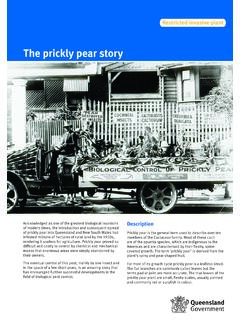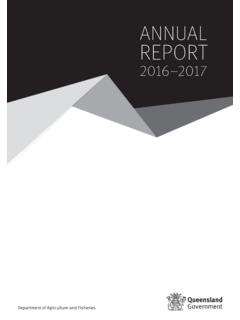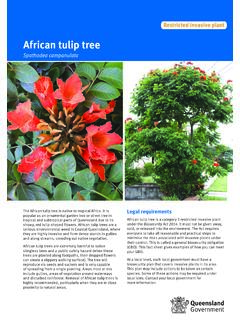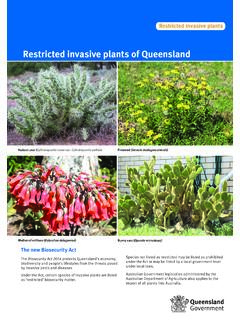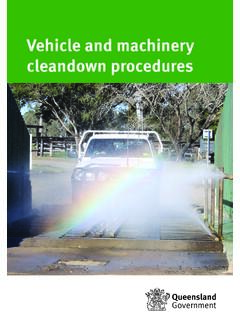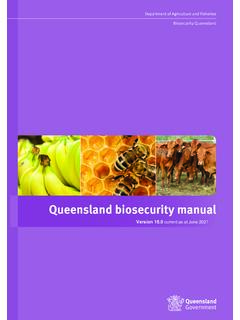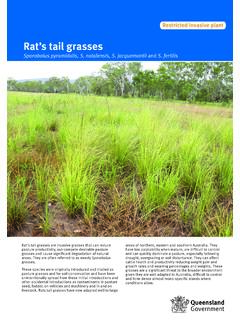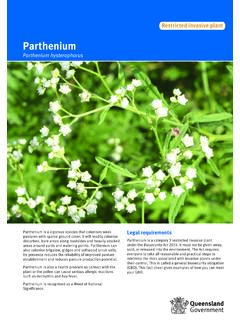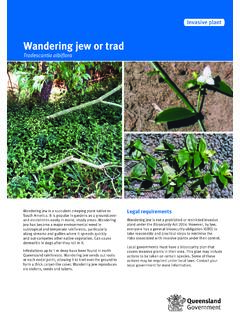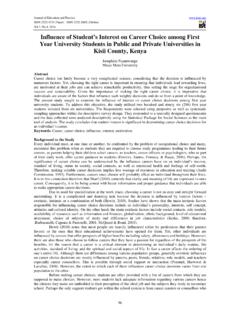Transcription of Northern IWM fact sheet - Department of Agriculture and ...
1 Northern IWM fact sheetFlaxleaf fleabane A weed best management guideCS1438 03/12 This difficult-to-control weed can be managed by applying a combination of chemical and non-chemical tactics in the cropping and fallow phases. However, this requires diligent monitoring and a focus on controlling sprayed survivors. This approach will drive the seed bank down to very low numbers within several years, with few problems in following years. To achieve this, consider the following key aspects of messages Flaxleaf fleabane is very susceptible to several residual herbicides that can be used in fallows and a range of crops. A strategic soil disturbance can create a soil environment unfavourable for germination. Small, actively growing weeds should be targeted weed age and, to a lesser extent, moisture stress have a substantial adverse impact on efficacy of knockdown and selective herbicides.
2 The mix of glyphosate and 2,4-D (Amicide Advance 700 ) or picloram + 2,4-D (Tordon 75-D ) effectively controls low-density infestations of young flaxleaf fleabane in fallows. The double-knock tactic is needed for controlling dense infestations, especially if the weeds are more than 1 month old in fallows. Several selective Group I herbicides provide good control of young flaxleaf fleabane in wheat. Crop competition suppresses flaxleaf fleabane growth and seed production. Good on-farm hygiene needs to be maintained, with emphasis on controlling flaxleaf fleabane in areas surrounding paddocks to prevent new problemFlaxleaf fleabane (Conyza bonariensis) is a major cropping weed in southern Queensland and Northern New South Wales. It is also emerging as a problem in other cropping regions of Australia. For many growers, fallow weed control costs have increased markedly due to this weed alone, and some zero-till farmers have needed to reintroduce cultivation as a last-resort control tactic.
3 Uncontrolled flaxleaf fleabane, even at a low density, has reduced sorghum yields by 60% to 100%.Furthermore, populations of flaxleaf fleabane have been confirmed recently as being resistant to glyphosate. These populations were found in zero- or minimum-tilled paddocks in southern Queensland and Northern New South Wales. As well, glyphosate-resistant populations were identified along roadsides near these cropping fleabane: a weed best management guide2 Despite this, a strategic approach using integrated weed management (IWM) will greatly reduce the impact of flaxleaf fleabane upon crop production. The key to getting on top of flaxleaf fleabane is to attack all parts of the weed life cycle and keep the seed bank low. Adopting an IWM strategy, which includes chemical and non-chemical tactics for controlling seedlings and preventing seed production on survivors, will result in substantially fewer flaxleaf fleabane problems and resistant populations in the the enemy DescriptionAlthough there are seven Conyza species naturalised in Australia, flaxleaf fleabane is the most widespread and the only one found in a recent survey of cropping paddocks in Northern New South Wales and southern Queensland.
4 Flaxleaf fleabane grows up to 1 m in height and has erect multiple-branching stems covered with stiff hairs. Leaves are grey-green, deeply indented, coarsely toothed and covered in fine hairs. Its branches often grow taller than the main plant axis .This contrasts with tall fleabane (C. sumatrensis), commonly found in roadsides and horticultural and other non-cropping areas, which grows up to 2 m and has a single stem with a pyramid-shaped inflorescence. Its leaves are less indented than flaxleaf fleabane and its branches do not grow taller than the main plant axis (Figure 1).Flaxleaf fleabane has a smoothly pitted receptacle (stalk of the flowering head), while tall fleabane has a roughly pitted receptacle. Both species are characterised by the production of fluffy, cream seed 1. Flaxleaf fleabane (top) and tall fleabane (bottom)EmergenceFlaxleaf fleabane emerges when temperatures are between 10 and 30 C, with the optimal temperature around 20 to 25 C.
5 Seed will only germinate in the presence of light, and seedlings will emerge only from the top 1 cm of soil, explaining partly why this weed proliferates in zero-tilled systems (Figure 2). Some seedlings can emerge under low light conditions, such as under dense southern Queensland, flaxleaf fleabane emerges predominantly in autumn, early winter and spring. There may be limited emergence if conditions are mild during mid-winter and early summer. Flaxleaf fleabane: a weed best management guide3 Figure 2. Flaxleaf fleabane seedlings emerging in zero-tilled fallowWhile seedlings that emerge in autumn grow slowly above-ground during winter, roots continue to grow deep into the soil to absorb available water. The building of such a strong root system during winter provides sufficient food reserve for rapid growth during the following spring. These over-wintered flaxleaf fleabane plants are therefore more difficult to productionA single mature flaxleaf fleabane plant can produce an average of 100 000 seeds (Figure 3)!
6 Each seed carries its own pappus, or umbrella of light hairs. This enables the seed to be easily lifted and dispersed by wind over considerable seed characteristics make flaxleaf fleabane a major weed problem, and highlight the importance of controlling all plants (including adjacent non-crop areas) to prevent major replenishment of the seed 3. A mature flaxleaf fleabane flowering prolificallySeed persistence in soilThe majority (90 95%) of flaxleaf fleabane seeds lose their viability within 12 to 18 months in the surface soil. However, a small percentage can persist for several years, particularly if seeds are buried 2 to 5 cm below the to herbicidesMany populations of flaxleaf fleabane in the cropping areas of southern Queensland and Northern New South Wales have developed resistance to glyphosate (Figure 4). Small rosettes of glyphosate-susceptible plants can be controlled well with glyphosate alone, unlike glyphosate-resistant seedlings.
7 Irrespective of resistance status, mature plants are very difficult to control with glyphosate alone and need other management 4. Control of flaxleaf fleabane seedlings treated with field rate of glyphosate. Seedlings were grown in a glasshouse from seed collected from non-cropping areas and cropping paddocks in southern Queensland (SQ) and Northern New South Wales (NSW)020100806040 Weed control (%)Q21Q34N19N18N15Q42Q33Q31Q28Q5 Non-croppingSQ croppingNSW croppingFlaxleaf fleabane: a weed best management guide4 Management strategiesFor paddocks infested with flaxleaf fleabane, tackling the problem will require a strategic approach based on good agronomy and integrated weed management (IWM) IWM depends on having a flexible plan that is based on a good understanding of the target weed and that uses a mix of weed control tactics. Key aspects of the IWM approach include the following.
8 Benchmark the current flaxleaf fleabane and paddock situation weed density and distribution, and herbicide histor y. Closely monitor flaxleaf fleabane emergence throughout the cropping system to ensure effective treatment of young seedlings. Use a variety of chemical and non-chemical tactics. Rotate between different herbicide groups, or tank mix with effective herbicides from different mode of action groups it is important to use robust rates for both herbicides in the mix. Aim for maximum effectiveness to keep weed numbers low the primary aim of weed control is to minimise their impact on productivity , and resistance is much less likely to develop in paddocks with fewer weeds than in heavily infested paddocks. Ensure survivors do not set seed and replenish the soil seed bank consider using the double-knock tactic, particularly for dense infestations or larger weeds.
9 Avoid introducing or spreading flaxleaf fleabane, and manage this weed in surrounding non-crop areas to minimise the risk of seeds moving into adjacent paddocks. Review the control achieved, and adjust future management strategies tacticsFor optimal control of flaxleaf fleabane, we recommend targeting all parts of the weed life cycle. An IWM strategy, which combines chemical and non-chemical tactics to deplete the seed bank, control seedlings, stop seed production and seed rain, and prevent introduction of new seeds, will significantly reduce the impact of this weed bank depletionResearch has shown that a number of residual herbicides give good control of flaxleaf fleabane seedlings for several months in fallow, at pre-plant and during the crop phase. Most residuals do not control emerged flaxleaf fleabane. Therefore, these herbicides need to be applied to a clean paddock; otherwise they can be applied following, or mixed with, an effective knockdown herbicide or double-knock.
10 The Group C triazine herbicide was very effective when applied in a winter or early spring fallow prior to sorghum when rainfall was received within 1 to 2 weeks of spraying. This is because rainfall is needed to incorporate the herbicide into the soil to control germinating seed. This residual herbicide at robust rates provided excellent control throughout the spring fallow and early sorghum crop (Figure 5). Figure 5. Excellent residual control from Group C triazine herbicide (right) applied following a double-knock in spring fallow prior to sowing sorghum, compared with untreated (left)Flaxleaf fleabane: a weed best management guide5As well, the Group C urea (used prior to cotton), Group B sulfonylurea (used prior to wheat) and Group H isoxazole (used prior to chickpea) were very effective in reducing emergence for several months. Figure 6 shows the level of control achieved for 6 months when these residuals were mixed with the double-knock of glyphosate + 2,4-D or glyphosate + Tordon 75-D.
